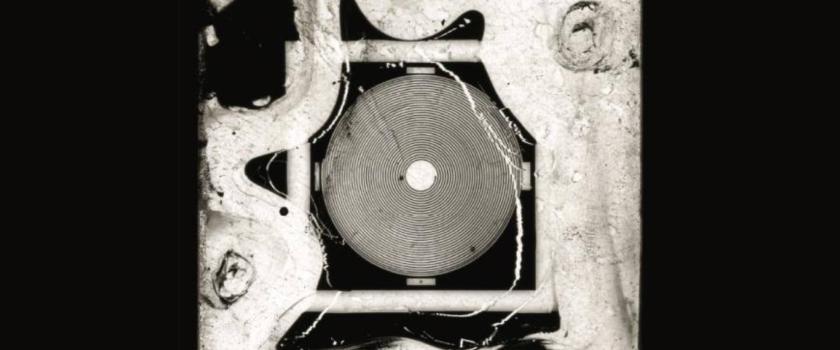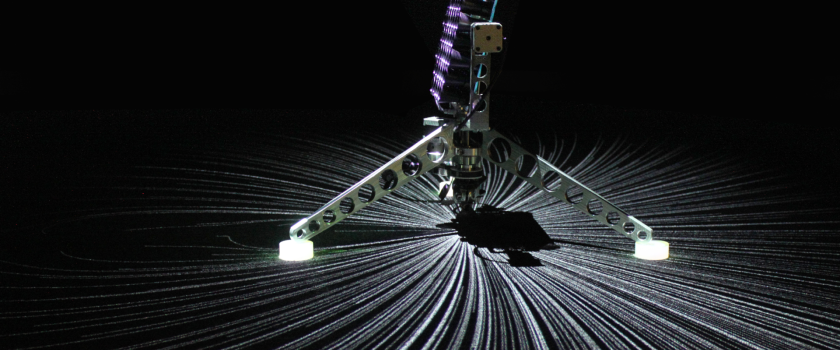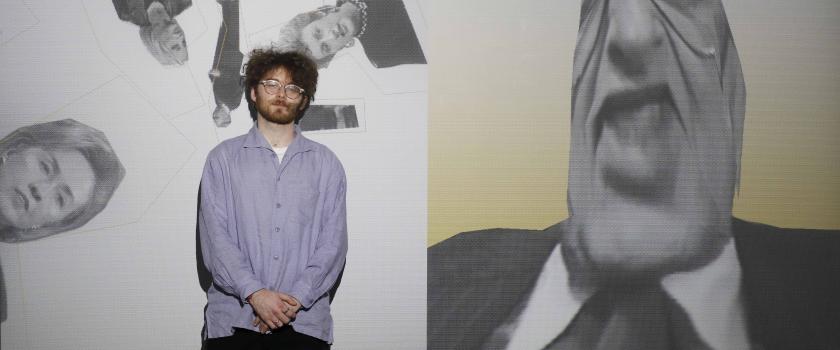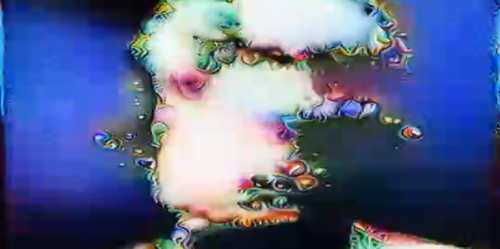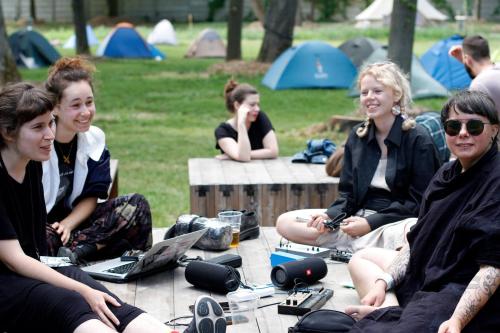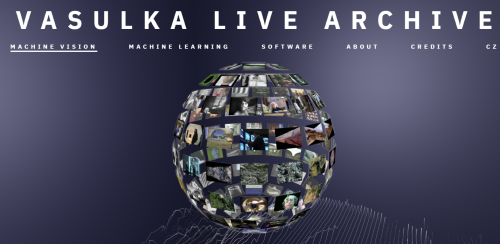Vasulka Live Archive / Interfaces
We kindly invite you to the presentations of the Vasulka Live Archive project, that reflects several years of collaboration between art historians and programmers to mediate the work of Steina and Woody Vasulka using artificial intelligence and interactive interfaces. Vasulka Kitchen Brno was the research project’s guarantor of the application along with the Brno House of Arts. The exhibition opening will be followed by an audio-visual performance by the British improv father and daughter duo Yeah You - Mykl Jaxn and Elvin Brandhi. They will perform songs from their latest album KRUTCH.
The opening programme 17.2.:
17–18h (lecture hall of Brno House of Arts) - VASULKA LIVE archive.net, introduced by Jana Horáková, Pavel Sikora, Štěpán Miklánek, Dušan Barok
The research team will present the aims, work methods, and results of artificial intelligence’s usage (machine learning) within the processing of Steina and Woody Vašulka’s archive content focused on audiovisual works. Visitors will be able to dip into the background of the project, discuss selected methods, and the final form of web vasulkalivearchive.net, which works as an epistemological tool for studying Vašulka’s artwork specialized in iconographic analysis.
18–19h (exhibition spaces of Vasulka Kitchen Brno) - Opening of the exhibition VASULKA LIVE ARCHIVE / INTERFACES
Jana Horáková, Jiří Mucha (curators), Media Art Live Archive team (MU and VUT), application guarantors – Vasulka Kitchen Brno, Brno House of Arts.
19–20h (entrance hall of Brno House of Arts)- audiovisual performance of British improvising duo Yeah You
The first part of the exhibition triptych Vasulka Live Archive / Interfaces, a large-scale video mapping on the House of Art, took place at the end of 2022. It follows up with the second part consisting of an immersive virtual reality exhibition. Visitors will be able to immerse themselves through VR goggles, and a multi-channel video installation of Machine Dreaming, presenting Vasulka's videos decomposed through pseudo-cognitive processes of artificial intelligence. The third part of the exhibition is the Machine Vision website with its unique features, that can be accessed online on a computer, tablet, or phone. The triptych offers different perspectives on how artificial neural networks can work with iconographic analysis of videos by Vasulkas.
Experimentation with artificial intelligence in art research is the foundation of the Vasulka Live Archive project. It focuses on the use of the features of intelligent software (image recognition technologies) for iconographic analysis of Vasulka’s work and explores various possibilities of visualizing the results by artificial intelligence.
Vasulka Live Archive / Interfaces is not an exhibition project in the sense of presenting new artworks or remakes of the Vasulka’s work. Visitors’ attention is directed to the new types of interfaces of the Vasulka archive content that have been developed by the authors of the research project. These new interfaces are epistemological tools (new cultural forms associated with the spread of information and communication technologies) that provide “new capabilities of data access and manipulation. Their techniques include hypermedia, databases, search engines, data mining, image processing, visualization and simulation” (Manovich 2003, p. 23).
While the chosen triptych format is dispersive and therefore it is possible to see the individual outputs asynchronously, the exhibition is a unique opportunity to present these interfaces side by side, within their mutual relations and broader context. Vasulka’s work will be introduced in the environment of a laboratory dedicated to researching an emerging discipline – “iconology in the age of AI.” (Spratt, 2017, p. 12).
The main focus of the research project is the Vasulka Live Archive website, in particular its analytical part Machine Learning, which is a specifically designed interface for the Steina and Woody Vasulka’s archive, allowing to search the set of audio-visual artworks by this artistic duo, both according to standard identifiers (author, title of the work, year) and using specially untrained artificial neural networks that are able to sort the archive content based on recurring images and sound objects.
The multi-channel video installation displays particular layers of the classification neural network model. Displayed images are created by inserting an image into the network, that does disseminate them according to a vector of classification values. The process is terminated early, and the partially decomposed image is subsequently visualized using the Lucid library. The deeper into the network we allow the image to get, the more unreal the image becomes.
Vasulka Live Archive – virtual reality
A fully immersive virtual reality, including the functionalities of the Vasulka Live Archive website, was created especially for use in the Vasulka Kitchen Brno gallery space. The virtual environment provides the visitor with a ‘cybernaut’ experience: diving into the exhibition space of Vasulka Kitchen Brno with video mapping of the Machine Vision website and the universe with videos as space objects. The videos can be manipulated (moved, zoomed in, zoomed out, enlarged or shrunk) and replayed.
An integral part of the exhibition is also a series of lectures by the research project team members. The individual phases of the project will be described as well as the aspects of interdisciplinary collaboration within the team.
3.3.
16–17.30 h - studio: additional programme to the exhibition Vasulka Live Archive: Virtual reality (Chamit Abdulvaliyev) and video mapping (Jiří Mucha, Jana Horáková)
/ 30 + 30 min. lecture, discussion
17.3.
16–17.30 h - studio: additional programme to the exhibition Vasulka Live Archive: AI software and Machine dreaming (Pavel Sikora, Štěpán Miklánek) / 30 + 30 min. lecture, discussion
Curators: Jana Horáková, Jiří Mucha Postproduction of audiovisual materials: Jiří Mucha Programme of artificial intelligence and visualization: Pavel Sikora, Štěpán Miklánek (s využitím knihovny Lucid a TensorFlow) Web design: Dušan Barok Virtual reality: Chamit Abdulvaliyev
Manovich, Lev (2003). New Media from Borges to HTML, in: New Media Reader, ed. By Noah Wardrip-Fruin and Nick Montfort. Cambridge – London: MIT Press, 2003, p. 13–25, p. 23. Alexander Mordvistev, Christopher Olah, and Mike Tyka (2015). Inceptionism: Going Deeper into Neural Networks, Google AI Blog. Online: Spratt, Emily L. (2017). Dream Formulations and Deep Neural Networks: Humanistic Themes in the Iconology of the Machine-Learned Image, in: Critical Approaches to Digital Art History, ed. by Angela Dressen and Lia Markey, in: kunsttexte.- de, Nr. 4, 2017 (15 pages). DOI: 10.18452/18693
Jana Horáková is an Associate Professor in new media arts at the Faculty of Arts, Masaryk University, she is also the head of Theory of Interactive Media and Digital Culture and Creative Industries study programmes there. For several years she has been researching the use of new media in art research with a focus on new media art. As her first contribution to this topic can be considered the publication Introduction to Software Studies (2014), in which she described the transformative influence of artistic practice (software art, code works, live coding performances, artistic viruses, etc.) on the academic and theoretical discipline of new media art. In 2017 and 2018, she participated in a research-based reconstruction of one of the first computer art exhibitions (Computer graphic, 1968, curator: Jiří Valoch, Brno House of Arts) in collaboration with her graduate Jiří Mucha, using a fully immersive virtual reality. The virtual exhibition Computer Graphic Re-visited was opened at the Brno House of Arts (2017, 2018) and presented at the Ars Electronica festival in Linz, Austria (2018). The results of the project were published in a prestigious academic journal IEEE (2019). She is the main investigator of the Media Art Live Archive research project (2018-2022), funded by the Technology Agency of Czech Republic. The main outputs of this research project are presented at this exhibition.
Jiří Mucha graduated from the Theory of Interactive Media at Masaryk University in 2018. Under the supervision of Jana Horáková, his thesis focused on the reconstruction of the significant exhibition Computer Graphic (1968) curated by Jiří Valoch from Brno. In 2018, Jiří Mucha and Jana Horáková also presented the results of archival research at the Brno House of Arts in a form of virtual reality and in 2021 they presented the results again at the international festival Ars Electronica in Linz, Austria. He is a director and screenwriter of audio-visual projects at MUCHA studio, which he also manages.
The exhibition is a part of the project Media Art Live Archive: Intelligent Interface for Interactive Mediation of Cultural Heritage (no. TL02000270) co-funded by the ÉTA programme, Technology Agency of the Czech Republic. Along with the Brno House of Arts, Vasulka Kitchen Brno is the guarantor of application.
The programme of Vasulka Kitchen Brno is funded by the Statutory City of Brno and the Ministry of Culture of the Czech Republic.
